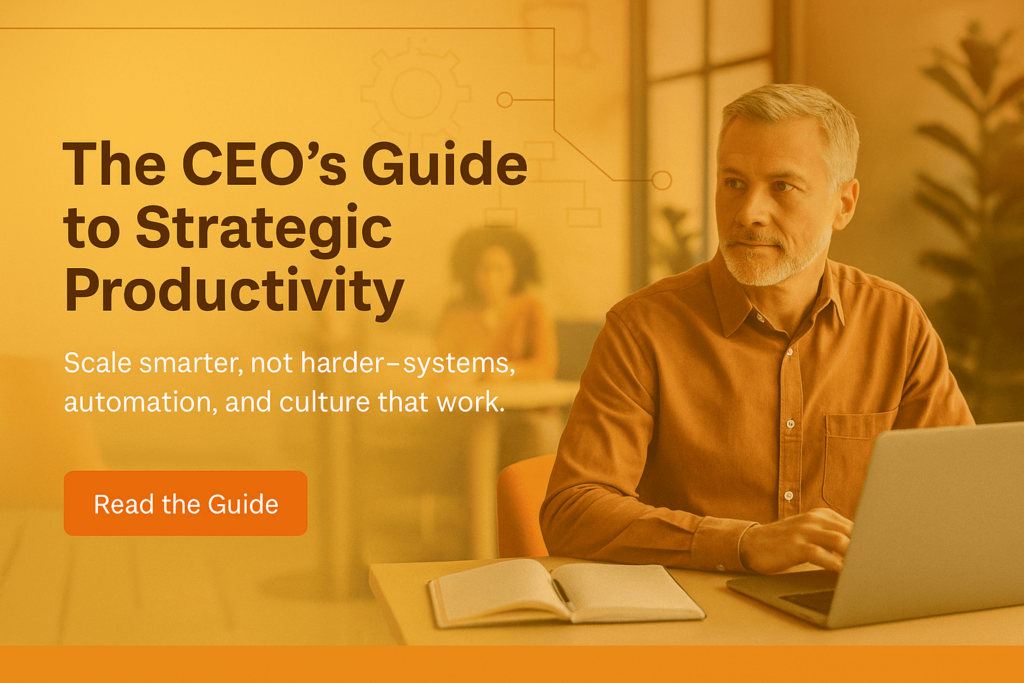Table of Contents
ToggleCEOs don’t operate in silos. They architect productivity frameworks that leverage technology, organizational expertise, and sustainable structures to drive results. Yet many leaders find themselves trapped in “hustle culture”. Although it can deliver short-term results, it’s not a sustainable strategy. True leadership isn’t about running a perpetual sprint; it’s about building a machine that can run a marathon. It’s time to shift from frantic activity to strategic productivity that respect human capabilities while amplifying collective impact.
This guide explores the transition from traditional, exhausting productivity methods to modern, scalable strategies. We’ll examine why the old ways fail and how to build a company that grows through smart systems, not just sheer effort. By embracing strategic productivity, you can increase output, reduce burnout, and position your organization for long-term success.
The Flaws of Traditional Productivity
For decades, the accepted wisdom for getting more done was simple: do more. This approach, rooted in the industrial age, treats time and effort as the primary inputs for success. While dedication is crucial, relying solely on it leads to significant problems.
The Trap of Long Hours and Micromanagement
The traditional model often manifests in a culture where long hours are a badge of honor. Leaders might find themselves trapped in a cycle of micromanagement, believing that direct oversight of every task ensures quality. This hands-on approach might feel productive, but it creates bottlenecks. When every decision must pass through the CEO, the entire organization slows down.
This method also fosters reactive decision-making. Instead of working from a strategic plan, leaders spend their days putting out fires. Each new problem demands immediate attention, pulling focus away from high-impact activities like strategy, innovation, and culture-building. The result is a team that is always busy but not necessarily productive, and a CEO who is exhausted but not effective.
The Inevitable Burnout
The most significant consequence of hustle culture is burnout. When employees are consistently pushed to their limits, their engagement, creativity, and overall well-being suffer. High turnover becomes a risk, as talented individuals seek healthier work environments. This isn’t just a personnel issue; it’s a financial one. The cost of recruiting, hiring, and training new employees far outweighs the investment in creating a sustainable work culture.
For the CEO, this path leads to decision fatigue and a loss of strategic vision. When you spend all your energy on the day-to-day grind, you have nothing left for the big-picture thinking that only you can provide.
Embracing Modern, Scalable Productivity
Strategic productivity is about achieving more by working smarter, not just harder. It’s a shift from managing people to designing systems. Instead of being the engine, the CEO becomes the architect of the engine. This approach focuses on creating processes and leveraging tools that allow the team to operate efficiently and autonomously.
Measure What Matters
A core principle of a sustainable productivity strategy is measuring what truly matters. Organizational leaders must look beyond just revenue as the sole indicator of success. Focusing on a healthy mix of metrics—such as revenue growth, quality of output, speed of delivery, diversity of projects, and employee happiness—fosters a more balanced and resilient business. When teams understand that success is measured by impact, innovation, and well-being, not just numbers on a spreadsheet, they are empowered to pursue excellence and sustainable growth from all angles.
Prioritize and Delegate with Purpose
A common leadership failure is trying to do everything. Strategic productivity demands ruthless prioritization. Use frameworks like the Eisenhower Matrix to categorize tasks by urgency and importance. Focus your energy on what is important but not necessarily urgent—these are the strategic activities that drive long-term growth.
Effective decentralization is the other side of this coin. Once you’ve built reliable systems, you can confidently hand off responsibility. Delegation isn’t just about offloading work; it’s about empowering your team. You can even entrust the team with the responsibility of designing and implementing the systems. When you entrust employees with meaningful endeavors, you foster a sense of ownership and professional development. This frees you to concentrate on your most critical responsibilities: setting the vision, securing resources, and building key relationships.
Build Systems, Not Just Tasks
The core of scalable productivity is system design. A system is a repeatable process that produces a consistent result. Think about the onboarding process for a new client or the steps for launching a marketing campaign. By documenting and standardizing these workflows, you eliminate guesswork and ensure quality, regardless of who is performing the task.
Start by identifying recurring activities in your business. Work with your team to map out the most efficient way to complete them. This creates a playbook that empowers your team to act without constant supervision. For example, a documented sales process ensures every lead receives the same high-quality experience, turning a variable activity into a predictable system.
Leverage Technology and Automation
In today’s landscape, technology is a powerful ally in building scalable systems. Automation tools can handle repetitive, low-value tasks, freeing up human capital for more creative and strategic work.
Consider the areas of your business that are ripe for automation:
- Marketing: Automate email sequences, social media posting, and lead nurturing.
- Operations: Use artificial intelligence to streamline meeting notes and action item identification.
- Finance: Implement tools for automated invoicing, expense tracking, and financial reporting.
E.ON, a German energy company, realized that team members in organization were spending too many hours capturing meeting notes and looking for files embedded in emails, chats, and other sources. By investing in a MS Copilot chat, E.ON automated meeting transcribing and minuting, simplified data aggregation, streamlined file location, which saved E.ON team members hundreds of hours a year. This allowed them to focus on their main line of business – supply electricity to hundreds of thousands of homes.
Fostering a Culture of Strategic Productivity
Implementing these strategies requires more than just new tools; it demands a cultural shift. As the CEO, you set the tone. Your actions and values will determine whether the organization truly embraces a new way of working.
Lead by Example
If you want your team to stop glorifying long hours, you must be the first to do so. Leave the office at a reasonable time. Take your vacation days. Talk openly about the importance of rest and focus. When your team sees you prioritizing strategic work over busywork, they will follow your lead.
Encourage Empowerment and Innovation
Create an environment where employees feel safe to suggest better ways of doing things. Reward team members who find ways to streamline processes or automate tasks. This fosters a mindset of continuous improvement, where everyone is invested in making the organization more efficient.
Focus on Outcomes, Not Hours
Shift your measurement of success from hours worked to results achieved. Set clear goals and key performance indicators (KPIs) for your team, then give them the autonomy to figure out the best way to reach them. This outcome-oriented approach builds trust and encourages creative problem-solving. It demonstrates that you value their contribution, not just their presence.
Your Next Steps Toward Strategic Leadership
Moving from a hustle-driven mindset to a system-driven one is a journey, not an overnight switch. It requires patience, discipline, and a genuine commitment to building a sustainable and scalable organization.
Start small. Pick one recurring process in your business and work with your team to systematize it. Identify one repetitive task you can automate. Delegate one responsibility you’ve been holding onto for too long. Each small step builds momentum and demonstrates the power of this new approach.
By embracing strategic productivity, you do more than just improve your own effectiveness. You build a resilient, efficient, and empowered organization capable of thriving in any environment. You stop just leading a team that hustles and start designing a system that scales.
About the Author

Rochelle Tan
As an Agile Evangelist, Rochelle Tan has over 20+ years of experience in agile transformation with small to large organizations from various industries in North America and Asia: Oil and Gas, IT, Healthcare, Finance, Insurance, and Government.
